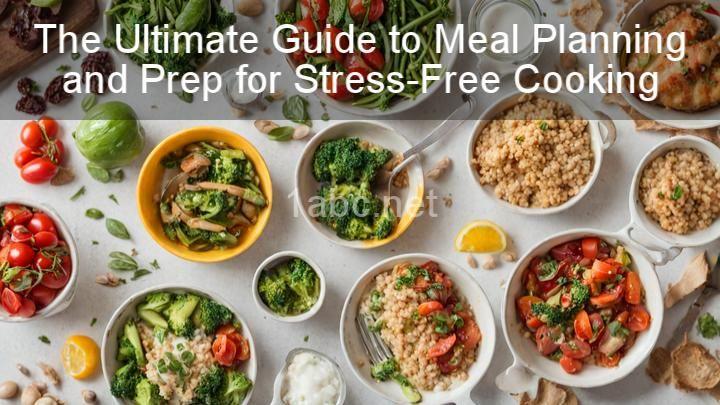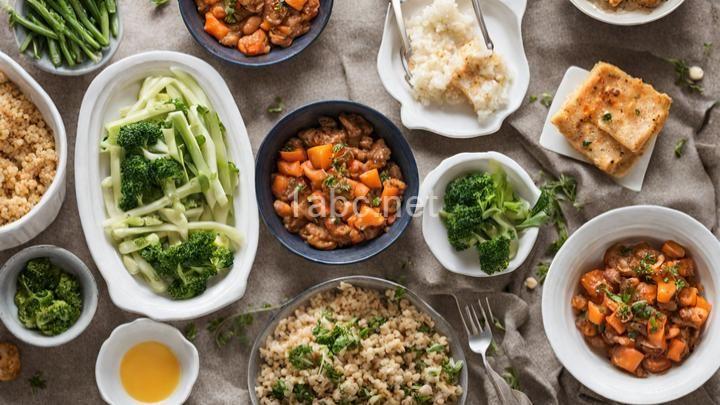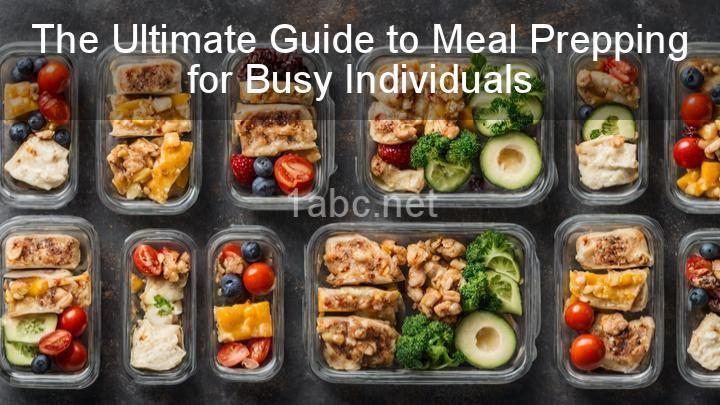The Ultimate Guide to Meal Planning and Prep for Stress-Free Cooking
Introduction:
Section 1: Benefits of Meal Planning
Section 2: Getting Started with Meal Planning
Section 3: Creating a Weekly Meal Plan
Section 4: Making a Shopping List
Section 5: Prepping Ingredients in Advance
Section 6: Storing Meals Properly
Section 7: Tips for Streamlining Meal Prep Process
Conclusion:

Introduction:
Welcome readers to this ultimate guide to meal planning and prep! In this blog post, we will explore the world of meal planning and prep and how it can revolutionize your cooking experience. Whether you're a busy parent, a working professional, or just someone looking to make healthier choices, meal planning and prep can save you time, reduce stress, and help you maintain a healthy diet. So let's dive in and discover the benefits of this incredible practice.
Section 1: Benefits of Meal Planning
Meal planning offers a multitude of benefits that go beyond just saving time. One of the major advantages is saving money. By planning your meals in advance, you can make a comprehensive shopping list and avoid impulsive purchases. Additionally, meal planning helps in reducing food waste as you only buy what you need and use leftovers creatively. This not only benefits your wallet but also the environment.
Another significant advantage of meal planning is the ability to make healthier choices. When you plan your meals in advance, you have control over the ingredients and portion sizes. This allows you to incorporate more nutritious foods while avoiding unhealthy takeout or processed options. Moreover, meal planning helps in portion control, leading to a more balanced and mindful eating habit.
Lastly, the convenience factor cannot be overlooked. Imagine coming home after a long day at work, knowing that you have pre-planned meals waiting for you. Meal planning ensures that you always have a backup plan, preventing you from ordering unhealthy fast food or skipping meals altogether when you're pressed for time.
Section 2: Getting Started with Meal Planning
Now that we understand the benefits, let's discuss how to get started with meal planning. The first step is to take an inventory of your pantry and fridge. This will give you an idea of what ingredients you already have and what you need to restock. It's also an excellent opportunity to declutter and organize your kitchen.
Next, set realistic goals and consider any dietary restrictions or preferences. Do you want to include more vegetarian meals? Are there certain ingredients you want to use more often? Think about what you and your family enjoy and what fits into your lifestyle.
Once you have an idea of your goals, gather recipe ideas or create a list of family favorites. There are countless websites, blogs, and cookbooks available for inspiration. You can even involve your family members in the process to make it a fun and collaborative experience.
Section 3: Creating a Weekly Meal Plan
Variety and balance are key when creating a weekly meal plan. Think about incorporating different food groups, flavors, and textures to keep meals interesting and appetizing. Divide your plan into different categories like breakfast, lunch, dinner, and snacks to ensure you cover all your nutritional needs throughout the day.
When organizing your meals, consider cooking times. For busy weekdays, include quick meals that can be prepared in under 30 minutes. On days when you have more time, experiment with slow cooker recipes or dishes that require longer cooking times. This way, you can have a mix of convenient and indulgent meals throughout the week.
Section 4: Making a Shopping List
Creating a shopping list is essential to stay organized and avoid unnecessary trips to the store. Start by reviewing your meal plan and noting down the ingredients required for each recipe. Categorize your shopping list based on sections in the store, such as produce, dairy, and pantry items. This will save you time and make your grocery shopping more efficient.
To take it a step further, consider using smartphone apps that allow you to create and share shopping lists. These apps often have features like recipe integration, price comparison, and reminders, making your shopping experience even smoother.
Section 5: Prepping Ingredients in Advance
Prepping ingredients in advance is a game-changer when it comes to meal planning and prep. Take some time on the weekend or a less busy day to pre-wash vegetables, chop ingredients, or marinate proteins. This will significantly reduce your cooking time during the week and make it easier to assemble meals quickly.
Another time-saving technique is batch cooking. Prepare larger quantities of certain components like grains, proteins, or sauces that can be used in multiple recipes throughout the week. Store them in separate containers, and you'll have ready-to-use building blocks for your meals.
Section 6: Storing Meals Properly
Proper storage is crucial to maintain freshness and prevent spoilage. Invest in airtight containers that are suitable for storing different types of food. Glass containers are an excellent choice as they are non-toxic, durable, and microwavable. Label your containers with the date and contents to keep track of what you have on hand.
If you have limited fridge space or want to plan meals further in advance, consider investing in a freezer. Freezing meals is a fantastic way to extend their shelf life. Portion meals into individual containers or freezer bags for easy access. Just be sure to use freezer-friendly containers or wrap the food properly to avoid freezer burn.
Section 7: Tips for Streamlining Meal Prep Process
To make meal prep even easier and more efficient, here are some additional tips:
- Get family members involved: Assign tasks to different family members to lighten the workload and make meal prep a fun family activity.
- Invest in time-saving kitchen tools: Tools like a food processor, slow cooker, or an Instant Pot can significantly cut down your cooking time and simplify the process.
- Utilize leftovers creatively: Instead of letting leftovers go to waste, incorporate them into new dishes. Leftover roasted chicken can be transformed into a salad or added to a stir-fry for a quick and delicious meal.
Conclusion:
Meal planning and prep can truly transform your cooking experience. It saves time, reduces stress, and helps you maintain a healthy diet. By following this ultimate guide, you'll be able to enjoy stress-free cooking and take control of your meals. So, give it a try and experience the joy of organized and enjoyable meals. Happy cooking!
FREQUENTLY ASKED QUESTIONS
What is The Ultimate Guide to Meal Planning and Prep for Stress-Free Cooking?
"The Ultimate Guide to Meal Planning and Prep for Stress-Free Cooking" is a comprehensive resource that provides tips, strategies, and recipes to help make meal planning and preparation a breeze. It is designed to assist individuals or families in creating healthy, delicious meals while minimizing stress and maximizing efficiency in the kitchen. This guide covers various aspects of meal planning, such as organizing your pantry, creating a weekly meal plan, making a grocery list, and prepping ingredients in advance. It also includes batch cooking ideas, time-saving techniques, and suggestions for incorporating leftovers into new meals. With step-by-step instructions and practical advice, this guide aims to simplify the cooking process and promote a more enjoyable and stress-free experience in the kitchen.
How can meal planning and prep help reduce stress in the kitchen?
Meal planning and prep can help reduce stress in the kitchen by providing structure and organization to the cooking process. Here are a few ways it can be helpful:
- Time-saving: Meal planning allows you to decide in advance what meals to prepare, saving you the time and effort of figuring out what to cook each day. By prepping ingredients and even cooking some components ahead of time, you can significantly reduce the amount of time spent in the kitchen on busy days.
- Reduced decision-making: With a meal plan in place, you won't have to make last-minute decisions about what to cook, which can be overwhelming. Knowing what's on the menu ahead of time eliminates this uncertainty and allows you to focus on simply executing the plan.
- Lowered grocery stress: Meal planning involves creating a shopping list based on your planned meals. This means you can avoid multiple trips to the grocery store and the stress of figuring out what to buy when you're already hungry and pressed for time.
- Healthier eating: When you have a meal plan, you have more control over the nutritional content of your meals. By planning balanced and nutritious meals in advance, you can ensure that you're nourishing your body properly and avoiding the stress of making unhealthy food choices.
- Reduced food waste: With meal planning, you're more likely to use up ingredients before they go bad. By knowing exactly what you need for each meal, you can minimize food waste and save money.
By implementing meal planning and prep techniques, you can create a more efficient and stress-free cooking experience in your kitchen.
Who is The Ultimate Guide to Meal Planning and Prep for Stress-Free Cooking suitable for?
The Ultimate Guide to Meal Planning and Prep for Stress-Free Cooking is suitable for anyone who wants to streamline their cooking process, save time, and reduce stress in the kitchen. Whether you are a busy professional, a student with a tight schedule, a parent juggling multiple responsibilities, or someone looking to improve their meal organization skills, this guide can be beneficial for you. It provides practical tips, step-by-step instructions, customizable meal plans, and helpful strategies to help you plan and prep meals efficiently.
What can I expect to learn from this guide?
From this guide, you can expect to learn the following:
- The basics of the topic or subject being covered
- Step-by-step instructions on how to perform specific tasks or actions
- Tips and tricks to enhance your understanding or improve your skills
- Best practices and recommended approaches for achieving desired outcomes
- Troubleshooting techniques or solutions to common issues
- Resources or references for further exploration or learning



